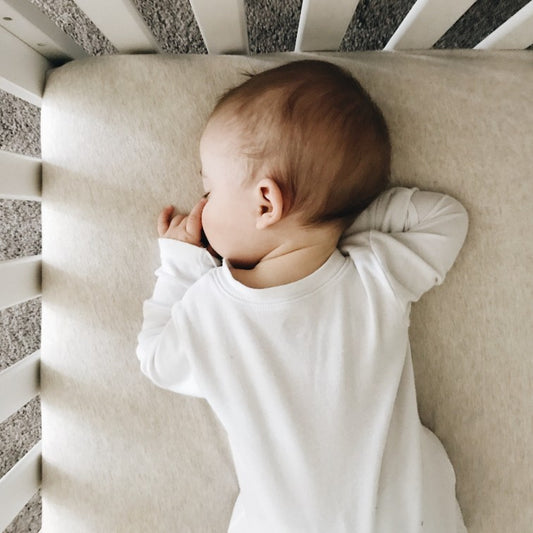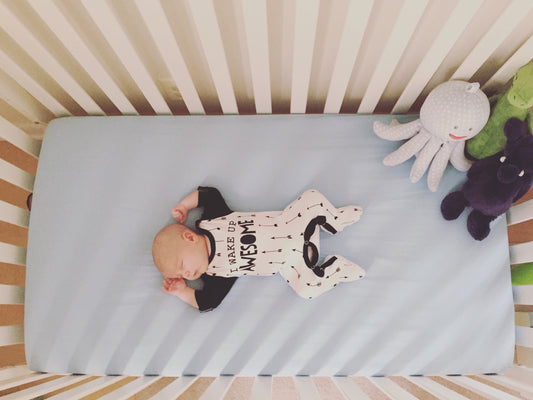How to Recognize Baby's Sleep Cues A.K.A. Baby's Sleep Window
Written by: Rachel Norman

I laugh at myself sometimes.
I was an amateur first time mom. I guess we all are though, right?
I hadn’t babysat a lot and am not even sure if I’d EVER held a baby before I had one. Much less a newborn.
I wanted baby to sleep well, eat well, and just be okay. When my firstborn was awake I’d watch her like a hawk waiting for her to yawn, tug on her ear, or start the little eye roll.
I remember vividly seeing her sleep cues then speed walking up the stairs to get her into bed within a minute or two of that yawn.
I would meet her sleep window!!!!!
Did you know that babies have a window of sleep? This is a period in which they are primed to go down for a rest and fall asleep on their own.
Often, after they’ve been up a short while, babies will begin to naturally become more sleepy. If you can identify that window and get baby down to sleep shortly then baby has a good chance of falling asleep on his own without mama having to jump through hoops.
Avoiding overtiredness
The best way to avoid overtiredness is to put baby down during his sleep window. Once babies becomes overtired then exhausted, they struggle to fall asleep and then, once they are asleep, they struggle to stay asleep.
How to avoid this? Put them down during their sleep window.
Recognizing the sleep window
A very important concept to remember is that of the sleep window. This is the point at which it will be easiest to get babies to nap or go to bed on their own because they are tired and showing signs of tiredness but not yet over-tiredness.
Crying, as a symptom of tiredness, is already past that point of fussiness. So if your children wake at 6:30 a.m. and by 1:30 p.m. they are fussy and crying, that’s a good sign that nap time should occur somewhere earlier. Perhaps at 12:30 or 1:00 p.m.
Babies and then toddlers will often tug their ears, yawn, eye roll, rub their eyes, and start acting slightly “out of it.” That’s your cue to know it is a good time to take them immediately to bed. If you pass the sleep window then they will likely become “overtired” which means they will have a difficult time getting to sleep and, once asleep, staying asleep.

Signs Your Baby Is Tired
Below are some signs that your baby is in their sleep window and could do for a nap. Finish the wind-down routine and put baby to bed if you recognize a few of these signs:
● Slower motor activity,
● Less babbling, cooing, or noises,
● Sucking is weaker or begins to slow down,
● Baby becomes quieter and calmer,
● Baby appears disinterested or is less social,
● Eyes begin to lose focus or glaze over,
● Eyelids droop and eyes can begin to roll back,
● More yawning than usual, and
● Pulling on the ears.
If you find yourself with a baby who is in their sleep window, this is great news! You can swaddle baby, do parts of your wind-down routine, then put baby to bed. Don’t begin a 20-minute wind-down routine if your baby is already tired because you don’t want them to catch their second wind.
If you miss the sleep window
If you miss baby’s sleep window he’ll likely have trouble getting to sleep. You may have to do some rocking, shushing, or put baby in a swing. The goal is to always put baby down during his window, but if you’ve missed it, it’s still important to do what it takes to keep baby well rested.
The SoundBub white noise machine will help your baby get quiet and calm so they’re able to sleep more. If you are trying to find your baby’s perfect sleep window, I suggest taking baby into their room, turning the lights low, turning on the SoundBub, and watching for baby’s sleep cues.
When baby gets into a familiar routine and recognizes the regular sleep associations her body will naturally calm down and get ready to sleep. Use WavHello’s VoiceShare app to play albums, songs, or even voice recordings you have for your baby. You can record a prayer, a poem, or something special you want them to remember.
As part of your baby’s wind down routine, many mothers find white noise invaluable. Using SoundBub’s white noise machine and Bluetooth speaker, you can make sure baby has soothing sounds in the background as he’s going to sleep.
This post is part of an 8-post series:
Part 1: What To Focus On During The First Week With A Newborn
Part 2: The Importance Of Swaddling: How And Why
Part 3: How To Create A Wind-Down Routine For Baby
Part 4: How To Recognize Baby’s Sleep Cues (you are here)
Part 5: Classic Signs Of Overtiredness And How To Prevent It
Part 6: A Surefire Way To Help Baby Sleep More Soundly
Part 7: Early Morning and Dream Feeds: How To Do Them And Wean Them
Part 8: The Art Of Teaching Baby To Sleep On Their Own






